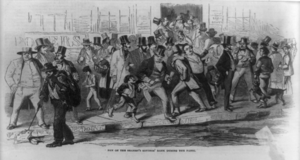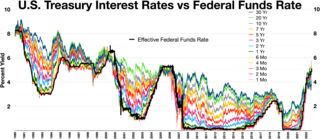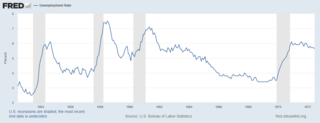| Name | Dates [lower-alpha 2] | Duration | Time since previous recession | Business activity [lower-alpha 3] | Trade & industrial activity [lower-alpha 3] | Characteristics |
|---|
| 1836–1838 recession | — | ~2 years | ~2 years | −32.8% | — | A sharp downturn in the American economy was caused by bank failures, lack of confidence in the paper currency, tightening of English Credit, crop failures and Jacksonian policy. [17] Speculation markets were greatly affected when American banks stopped payment in specie (gold and silver coinage). [1] [18] Over 600 banks failed in this period. In the Southern United States, the cotton market completely collapsed. [9] See: Panic of 1837. |
| late 1839–late 1843 recession | — | ~4 years | ~1 year | −34.3% | — | This was one of the longest and deepest depressions of the 19th century: it was a period of pronounced deflation and massive defaults on debt. The Cleveland Trust Company Index showed the economy spent 68 months below its trend, and only nine months above it, and declined 34.3% during this depression. [19] |
| 1845–late 1846 recession | — | ~1 year | ~2 years | −5.9% | — | This recession was mild enough that it may have only been a slowdown in the growth cycle. One theory holds that this would have been a recession, except the United States began to gear up for the Mexican–American War, which began April 25, 1846. [16] |
| 1847–1848 recession | late 1847 – late 1848 | ~1 year | ~1 year | −19.7% | — | The Cleveland Trust Company Index declined 19.7% during 1847 and 1848. It is associated with a financial crisis in Great Britain. [19] [20] |
| 1853–1854 recession | 1853 – December 1854 | ~1 year | ~5 years | −18.4% | — | Interest rates rose in this period, contributing to a decrease in railroad investment. Security prices fell during this period. With the exception of falling business investment, there is little evidence of contraction in this period. [1] |
| Panic of 1857 | June 1857 – December 1858 | 1 year 6 months | 2 years 6 months | −23.1% | — | The failure of the Ohio Life Insurance and Trust Company burst a European speculative bubble in United States' railroads and caused a loss of confidence in American banks. Over 5,000 businesses failed within the first year of the Panic, and unemployment was accompanied by protest meetings in urban areas. This recession was one of the main causes of the American Civil War, which would begin in 1861 and end in 1865. This is the earliest recession to which the NBER assigns specific months (rather than years) for the peak and trough. [6] [8] [21] |
| 1860–1861 recession | October 1860 – June 1861 | 8 months | 1 year 10 months | −14.5% | — | There was a mild recession before the American Civil War, which began on April 12, 1861, although the recession was only limited to some areas. Zarnowitz says the data generally show a contraction occurred in this period, but it was quite mild. [19] A financial panic was narrowly averted in 1860 by the first use of clearing house certificates between banks. [9] |
| 1865–1867 recession | April 1865 – December 1867 | 2 years 8 months | 3 years 10 months | −23.8% | — | The American Civil War ended in April 1865, and the country entered a lengthy period of general deflation that lasted until 1896. The United States occasionally experienced periods of recession during the Reconstruction Era. Production increased in the years following the Civil War, but the country still had financial difficulties. [19] The post-war period coincided with a period of some international financial instability. |
| 1869–1870 recession | June 1869 – December 1870 | 1 year 6 months | 1 year 6 months | −9.7% | — | A few years after the Civil War, a short recession occurred. It was unusual since it came amid a period when railroad investment was greatly accelerating, even producing the First transcontinental railroad. The railroads built in this period opened up the interior of the country, giving birth to the Farmers' movement. The recession may be explained partly by ongoing financial difficulties following the war, which discouraged businesses from building up inventories. [19] Several months into the recession, there was a major financial panic. |
| Panic of 1873 and the Long Depression | October 1873 – March 1879 | 5 years 5 months | 2 years 10 months | −33.6% (−27.3%) [lower-alpha 3] | — | Economic problems in Europe prompted the failure of Jay Cooke & Company, the largest bank in the United States, which burst the post-Civil War speculative bubble. The Coinage Act of 1873 also contributed by immediately depressing the price of silver, which hurt North American mining interests. [22] The deflation and wage cuts of the era led to labor turmoil, such as the Great Railroad Strike of 1877. In 1879, the United States returned to the gold standard with the Specie Payment Resumption Act. This is the longest period of economic contraction recognized by the NBER, though the Long Depression is sometimes held to be the entire period from October 1873 to December 1896. [23] [24] |
| Depression of 1882–1885 | March 1882 – May 1885 | 3 years 2 months | 3 years | −32.8% | −24.6% | Like the Long Depression that preceded it, the recession of 1882–1885 was more of a price depression than a production depression. From 1879 to 1882, there had been a boom in railroad construction which came to an end, resulting in a decline in both railroad construction and in related industries, particularly iron and steel. [25] A major economic event during the recession was the Panic of 1884. |
| 1887–1888 recession | March 1887 – April 1888 | 1 year 1 month | 1 year 10 months | −14.6% | −8.2% | Investments in railroads and buildings weakened during this period. This slowdown was so mild that it is not always considered a recession. Contemporary accounts apparently indicate it was considered a slight recession. [26] |
| 1890–1891 recession | July 1890 – May 1891 | 10 months | 1 year 5 months | −22.1% | −11.7% | Although shorter than the recession in 1887–1888 and still modest, a slowdown in 1890–1891 was somewhat more pronounced than the preceding recession. International monetary disturbances are blamed for this recession, such as the Panic of 1890 in the United Kingdom. [26] |
| Panic of 1893 | January 1893 – June 1894 | 1 year 5 months | 1 year 8 months | −37.3% | −29.7% | The failure of the United States Reading Railroad and withdrawal of European investment led to a stock market and banking collapse: this Panic was also precipitated in part by a run on the gold supply. The Treasury had to issue bonds to purchase enough gold. Profits, investment and income all fell, leading to political instability, the height of the U.S. populist movement and the Free Silver movement. [27] Estimates on unemployment vary, it may have peaked anywhere from 8.2 to 18.4%. [28] |
| Panic of 1896 | December 1895 – June 1897 | 1 year 6 months | 1 year 6 months | −25.2% | −20.8% | The period of 1893–1897 is seen as a generally depressed cycle that had a short spurt of growth in the middle, following the Panic of 1893. Production shrank and deflation reigned. [26] |
| 1899–1900 recession | June 1899 – December 1900 | 1 year 6 months | 2 years | −15.5% | −8.8% | This was a mild recession in the period of general growth beginning after 1897. Evidence for a recession in this period does not show up in some annual data series. [26] |
| 1902–1904 recession | September 1902 – August 1904 | 1 year 11 months | 1 year 9 months | −16.2% | −17.1% | Though not severe, this downturn lasted for nearly two years and saw a distinct decline in the national product. Industrial and commercial production both declined, albeit fairly modestly. [26] The recession came about a year after a 1901 stock crash. |
| Panic of 1907 | May 1907 – June 1908 | 1 year 1 month | 2 years 9 months | −29.2% | −31.0% | A run on Knickerbocker Trust Company deposits on October 22, 1907, set events in motion that would lead to a severe monetary contraction. The fallout from the panic led to Congress creating the Federal Reserve System. [29] |
| Panic of 1910–1911 | January 1910 – January 1912 | 2 years | 1 year 7 months | −14.7% | −10.6% | This was a mild but lengthy recession. The national product grew by less than 1%, and commercial activity and industrial activity declined. The period was also marked by deflation. [26] |
| Recession of 1913–1914 | January 1913 – December 1914 | 1 year 11 months | 1 year | −25.9% | −19.8% | Productions and real income declined during this period and were not offset until the start of World War I increased demand. [26] Incidentally, the Federal Reserve Act was signed during this recession, creating the Federal Reserve System, the culmination of a sequence of events following the Panic of 1907. [29] Financial crisis of 1914 occurred following the assassination of Archduke Franz Ferdinand of Austria-Hungary, the subsequent July Crisis, and British declaration of war on Germany, which led to U.S. Treasury Secretary William Gibbs McAdoo to close the New York Stock Exchange beginning on July 31. [30] |
| Post-World War I recession | August 1918 – March 1919 | 7 months | 3 years 8 months | −24.5% | −14.1% | Severe hyperinflation in Europe took place over production in North America. This was a brief but very sharp recession and was caused by the end of wartime production, along with an influx of labor from returning troops. This, in turn, caused high unemployment. [31] |
| Depression of 1920–1921 | January 1920 – July 1921 | 1 year 6 months | 10 months | −38.1% | −32.7% | The 1921 recession began a mere 10 months after the post-World War I recession, as the economy continued working through the shift to a peacetime economy. The recession was short, but extremely painful. The year 1920 was the single most deflationary year in American history; production, however, did not fall as much as might be expected from the deflation. GNP may have declined between 2.5 and 7 percent, even as wholesale prices declined by 36.8%. [32] The economy had a strong recovery following the recession. [33] |
| 1923–1924 recession | May 1923 – June 1924 | 1 year 2 months | 2 years | −25.4% | −22.7% | From the depression of 1920–1921 until the Great Depression, an era dubbed the Roaring Twenties, the economy was generally expanding. Industrial production declined in 1923–24, but on the whole this was a mild recession. [26] [34] [35] [36] |
| 1926–1927 recession | October 1926 – November 1927 | 1 year 1 month | 2 years 3 months | −12.2% | −10.0% | This was an unusual and mild recession, thought to be caused largely because Henry Ford closed production in his factories for six months to switch from production of the Model T to the Model A. Charles P. Kindleberger says the period from 1925 to the start of the Great Depression is best thought of as a boom, and this minor recession just proof that the boom "was not general, uninterrupted or extensive". [37] [34] [38] [36] |












